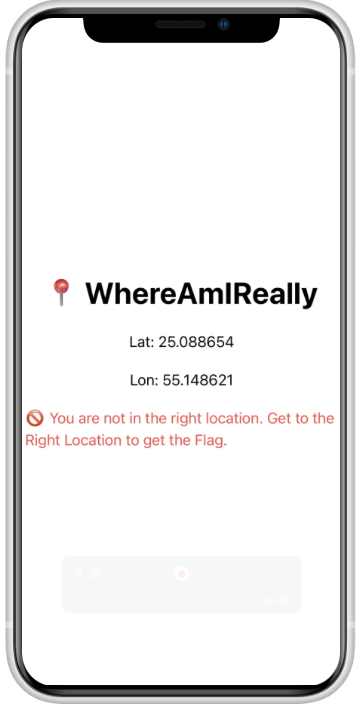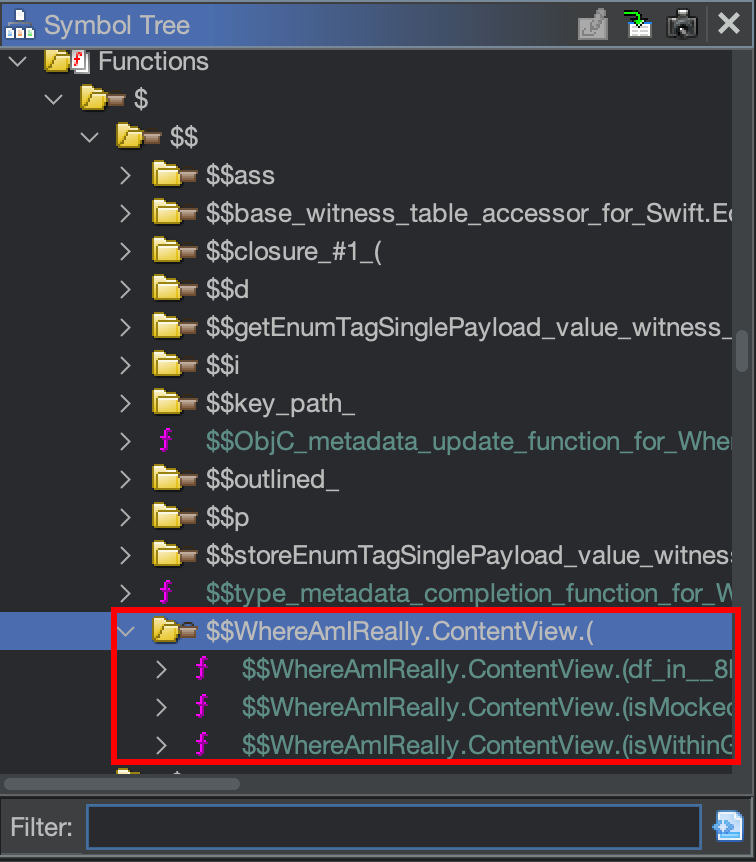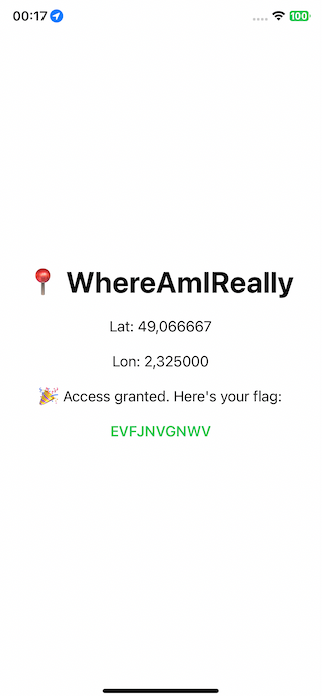8kSec WhereAmIReally¶
Link: https://academy.8ksec.io/course/ios-application-exploitation-challenges
Install an IPA file can be difficult. So, for make it more easy, I made a YouTube video with the process using Sideloadly. LINK: https://www.youtube.com/watch?v=YPpo9owRKGE
Once you have the app installed, let's proceed with the challenge. unzip the .ipa file.
Bypassing Jailbreak Detection¶
In first place, when we launch the application, we can see an message in the screen that says: Jailbroken device detected.
So, we need bypass that. But, for that, we can spend less time if we reverse the application.
Inside of Payload/WhereAmIReally.app directory, we can see the debug dylib file WhereAmIReally.debug.dylib.
Create a new Ghidra project and then, import that file.
In the Exports we can see the function isJailbroken():
bool __thiscall WhereAmIReally::JailbreakChecker::isJailbroken(JailbreakChecker *this)
{
[...]
VARIABLES
[...]
tVar8 = Swift::$_allocateUninitializedArray(0x18);
pSVar7 = (String *)tVar8.1;
SVar9 = Swift::String::init("/Applications/Cydia.app",0x17,1);
*pSVar7 = SVar9;
SVar9 = Swift::String::init("/Applications/Sileo.app",0x17,1);
pSVar7[1] = SVar9;
SVar9 = Swift::String::init("/Library/MobileSubstrate/MobileSubstrate.dylib",0x2e,1);
pSVar7[2] = SVar9;
SVar9 = Swift::String::init("/var/jb/usr/bin/bash",0x14,1);
pSVar7[3] = SVar9;
SVar9 = Swift::String::init("/var/jb/usr/bin/sshd",0x14,1);
pSVar7[4] = SVar9;
SVar9 = Swift::String::init("/private/var/mobile/Library/SBSettings/Plugins",0x2e,1);
pSVar7[5] = SVar9;
SVar9 = Swift::String::init("/Library/MobileSubstrate/DynamicLibraries",0x29,1);
pSVar7[6] = SVar9;
SVar9 = Swift::String::init("/Applications/RockApp.app",0x19,1);
pSVar7[7] = SVar9;
SVar9 = Swift::String::init("/Applications/Icy.app",0x15,1);
pSVar7[8] = SVar9;
SVar9 = Swift::String::init("/Applications/WinterBoard.app",0x1d,1);
pSVar7[9] = SVar9;
SVar9 = Swift::String::init("/Applications/SBSettings.app",0x1c,1);
pSVar7[10] = SVar9;
SVar9 = Swift::String::init("/Applications/MxTube.app",0x18,1);
pSVar7[0xb] = SVar9;
SVar9 = Swift::String::init("/Applications/IntelliScreen.app",0x1f,1);
pSVar7[0xc] = SVar9;
SVar9 = Swift::String::init("/Applications/FakeCarrier.app",0x1d,1);
pSVar7[0xd] = SVar9;
SVar9 = Swift::String::init("/Applications/blackra1n.app",0x1b,1);
pSVar7[0xe] = SVar9;
SVar9 = Swift::String::init("/private/var/stash",0x12,1);
pSVar7[0xf] = SVar9;
SVar9 = Swift::String::init("/private/var/lib/cydia",0x16,1);
pSVar7[0x10] = SVar9;
SVar9 = Swift::String::init("/private/var/log/syslog",0x17,1);
pSVar7[0x11] = SVar9;
SVar9 = Swift::String::init("/private/var/mobile/Library/Preferences/com.saurik.Cydia.plist",0x3e,
1);
pSVar7[0x12] = SVar9;
SVar9 = Swift::String::init("/private/var/mobile/Library/Preferences/com.saurik.Cydia",0x38,1);
pSVar7[0x13] = SVar9;
SVar9 = Swift::String::init("/private/var/tmp/cydia.log",0x1a,1);
pSVar7[0x14] = SVar9;
SVar9 = Swift::String::init("/private/var/lib/dpkg/info",0x1a,1);
pSVar7[0x15] = SVar9;
SVar9 = Swift::String::init("/private/var/lib/dpkg/status",0x1c,1);
pSVar7[0x16] = SVar9;
SVar9 = Swift::String::init("/private/var/lib/dpkg/available",0x1f,1);
pSVar7[0x17] = SVar9;
AVar1 = Swift::$_finalizeUninitializedArray(tVar8.0);
uVar2 = CONCAT44(extraout_var,AVar1);
local_30 = uVar2;
_swift_bridgeObjectRetain();
___swift_instantiateConcreteTypeFromMangledName();
Swift::Array<String>::$lazy_protocol_witness_table_accessor();
(extension_Swift)::Swift::Collection::$makeIterator();
while( true ) {
IVar3.unknown =
&$$demangling_cache_variable_for_type_metadata_for_Swift.IndexingIterator<[Swift.String]>;
___swift_instantiateConcreteTypeFromMangledName();
Swift::IndexingIterator::$next(IVar3);
if (local_50 == 0) {
$$outlined_destroy_of_Swift.IndexingIterator<>(&local_40);
_swift_bridgeObjectRelease(uVar2);
return false;
}
puVar4 = &_OBJC_CLASS_$_NSFileManager;
_objc_opt_self();
_objc_msgSend();
_objc_retainAutoreleasedReturnValue();
_swift_bridgeObjectRetain(local_50);
pNVar5 = (extension_Foundation)::Swift::String::_bridgeToObjectiveC();
_swift_bridgeObjectRelease(local_50);
puVar6 = puVar4;
_objc_msgSend(puVar4,"fileExistsAtPath:",pNVar5);
(*(code *)PTR__objc_release_00014080)(pNVar5);
(*(code *)PTR__objc_release_00014080)(puVar4);
if (((uint)puVar6 & 1) != 0) break;
_swift_bridgeObjectRelease(local_50);
}
_swift_bridgeObjectRelease(local_50);
$$outlined_destroy_of_Swift.IndexingIterator<>(&local_40);
_swift_bridgeObjectRelease(uVar2);
return true;
}
This isJailbroken() method implements a classic jailbreak detection technique based on checking suspicious files and directories.
Creates an array with 24 paths (0x18 in hex) of files and directories typical of jailbroken devices.
List of paths it searches for:
-
Jailbreak apps:
/Applications/Cydia.app,/Applications/Sileo.app -
Tools:
/var/jb/usr/bin/bash,/var/jb/usr/bin/sshd -
MobileSubstrate:
/Library/MobileSubstrate/MobileSubstrate.dylib -
Tweaking apps:
RockApp,Icy,WinterBoard,SBSettings, etc. -
Modified system directories:
/private/var/stash,/private/var/lib/cydia -
Cydia configuration files.
For each path:
-
Use
NSFileManagerto check if it exists (fileExistsAtPath:). -
If any file/directory is found then return
true(jailbroken).
We need get the Identifier for the app, for that:
In my case iscom.8ksec.WhereAmIReally.YX4C7J2RLK If we know what the app is checking for, we can directly hook and return false to any jailbreak file check.
So, we can simply do this Frida script:
(function(){
const targets = [
"Cydia.app","Sileo.app","MobileSubstrate","/var/jb/",
"cydia.plist","cydia.log","/var/lib/dpkg/"
];
const match = p => {
try { return targets.some(s => p.indexOf(s) !== -1); }
catch(_){ return false; }
};
try {
const FM = ObjC.classes.NSFileManager;
Interceptor.attach(FM['- fileExistsAtPath:'].implementation, {
onEnter(args){ this.block = match(ObjC.Object(args[2]).toString()); },
onLeave(r){ if (this.block) r.replace(ptr('0')); }
});
} catch(_){}
})();
And we can see that the jailbreak detection was bypassed!
NOTE
Your device may need to perform additional validations to bypass the jailbreak. The Ghidra feature provides the complete list. Please review the tweaks, tools, and libraries you have on your device and add them to the script.
Recon Location¶
Here we have a lot of functions we need to analyze, and some of them are really long. So I'll mention the """important""" code.
First, we have a kind of mock, which performs some validations. For example, if the geolocation is simulated and the source of the information.
The locationManager() function have these checks.
It is a CoreLocation callback method that processes location updates.
This function receives an array of CLLocations and get the last location.
Anti simulation/Xcode detection:
[...]
if (local_1c8 == (void *)0x0) {
(*(code *)PTR__objc_release_00014080)(local_1b8);
} else {
local_208 = local_1d0;
local_200 = local_1c8;
local_220 = local_1c8;
local_228 = local_1d0;
local_a0 = local_1d0;
local_98 = local_1c8;
(*(code *)PTR__objc_release_00014080)(local_1b8);
local_b0 = local_228;
local_a8 = local_220;
local_c0 = Swift::String::init("com.apple.dt", 0xc, 1);
in_x3 = local_c0.str;
local_218 = &local_c0;
Swift::String::$lazy_protocol_witness_table_accessor();
bVar3 = (extension_Foundation)::Swift::StringProtocol::$contains((char)local_218);
local_20c = (dword)CONCAT71(extraout_var, bVar3);
$outlined_destroy_of_Swift.String(local_218);
if ((local_20c & 1) == 0) {
_swift_bridgeObjectRelease(local_220);
} else {
local_250 = PTR_$type_metadata_for_Any_00014548 + 8;
tVar14 = Swift::$_allocateUninitializedArray(1);
local_260 = (String *)tVar14.1;
local_258 = tVar14._0_8_;
SVar21.str = (char *)((int)&mach_header_00000000.magic + 1);
SVar15 = Swift::String::init("[WARNING] Running from Xcode or simulator", 0x29, 1);
local_260[1].bridgeObject = PTR_$type_metadata_for_Swift.String_00014390;
*local_260 = SVar15;
pcVar9 = local_250;
[...]
[...]
[...]
Abnormal speed detection:
[...]
if (local_40 != (undefined *)0x0) {
local_130 = local_40;
local_138 = local_40;
local_50 = local_40;
_objc_msgSend(local_40, "speed");
uVar11 = 0x4072c00000000000;
cVar1 = (char)&stack0xfffffffffffffff0;
if (in_d0 <= 300.0) { // 300 m/s = 1080 km/h !!
puVar6 = &_OBJC_CLASS_$_NSBundle;
_objc_opt_self();
_objc_msgSend();
_objc_retainAutoreleasedReturnValue();
local_1b8 = puVar6;
_objc_msgSend();
_objc_retainAutoreleasedReturnValue();
local_1b0 = puVar6;
if (puVar6 == (undefined *)0x0) {
local_1d0 = (char *)0x0;
local_1c8 = (void *)0x0;
[...]
[...]
[...]
Old timestamp detection:
[...]
DVar7.unknown = local_138;
_objc_msgSend(local_138, "timestamp");
_objc_retainAutoreleasedReturnValue();
local_278 = DVar7.unknown;
DVar7 = Foundation::Date::$_unconditionallyBridgeFromObjectiveC(DVar7);
local_268 = Foundation::Date::get_timeIntervalSinceNow(DVar7);
(**(code **)(local_110 + 8))(local_100, local_118);
local_270 = -60.0;
(*(code *)PTR__objc_release_00014080)(local_278);
dVar12 = local_268;
if (local_268 < local_270) {
local_2a0 = PTR_$type_metadata_for_Any_00014548 + 8;
tVar14 = Swift::$_allocateUninitializedArray(1);
local_2b0 = (String *)tVar14.1;
local_2a8 = tVar14._0_8_;
SVar15.str = (char *)((int)&mach_header_00000000.magic + 1);
SVar20 = Swift::String::init("[WARNING] Location timestamp too old", 0x24, 1);
local_2b0[1].bridgeObject = PTR_$type_metadata_for_Swift.String_00014390;
*local_2b0 = SVar20;
pcVar9 = local_2a0;
[...]
[...]
[...]
Abnormal altitude detection:
_objc_msgSend(local_138, "altitude");
local_2b8 = 10000.0;
local_2c0 = dVar12;
(*(code *)PTR__objc_retain_00014088)(local_138);
dVar12 = local_2b8;
if (local_2c0 <= local_2b8) {
_objc_msgSend(local_138, "altitude");
dVar13 = -100.0;
local_2c4 = (dword)(dVar12 < -100.0);
}
Also, there are another locationManager() more short in Exports. But this handle the permissions of location.
Anyway, we will set the authorization always as true (3).
void __thiscall
WhereAmIReally::LocationManager::locationManager
(LocationManager *this, CLLocationManager *param_1,
CLAuthorizationStatus didChangeAuthorization)
{
bool bVar1;
__C::CLAuthorizationStatus::typeMetadataAccessor();
__C::CLAuthorizationStatus::$lazy_protocol_witness_table_accessor();
bVar1 = Swift::$==_infix(0xc4, 0xc0);
if (bVar1) {
bVar1 = true;
} else {
bVar1 = Swift::$==_infix(0xbc, 0xb8);
}
if (bVar1 != false) {
(**(code **)((*(uint *)this & *(uint *)PTR__swift_isaMask_000145e0) + 0xa0))(1);
}
return;
}
-
0xc4/0xc0: ProbablyauthorizedWhenInUse(4) orauthorizedAlways(3). -
0xbc/0xb8: Probably another authorized state.
In our hook, we will use this part of script:
// authorization
try {
const LM = ObjC.classes.CLLocationManager;
if (LM['+ authorizationStatus']) {
Interceptor.attach(LM['+ authorizationStatus'].implementation, {
onLeave(r) {
r.replace(ptr('3')); // authorizedAlways
}
});
}
log('auth/location services forced');
} catch (_) {}
Also, this will the hook for anti simulation code:
// anti-"simulated"
try {
const SI = ObjC.classes.CLLocationSourceInformation;
if (SI && SI['- isSimulatedBySoftware']) {
Interceptor.attach(SI['- isSimulatedBySoftware'].implementation, {
onLeave(r) {
r.replace(ptr('0'));
}
});
}
log('anti-simulation ON');
} catch (_) {}
But, what is the correct location for complete the challenge...?
Let's move to the $$WhereAmIReally.ContentView.(df functions!
You can found that in the Symbol Tree panel:
We can see the isMocked() function:
bool $WhereAmIReally.ContentView.(isMocked_in__8E3FC3B3FEF0CBBE848D4767CE9AAAEA)(location: ___C.CLLocation) -> _Swift.Bool
(int param_1)
{
sdword sVar1;
bool bVar2;
int iVar3;
dword local_3c;
byte local_23;
undefined local_22;
byte local_21;
_objc_msgSend(param_1, "sourceInformation");
_objc_retainAutoreleasedReturnValue();
if (param_1 == 0) {
local_3c = 2;
} else {
iVar3 = param_1;
_objc_msgSend(param_1, "isSimulatedBySoftware");
local_3c = (dword)iVar3;
(*(code *)PTR__objc_release_00014080)(param_1);
}
local_22 = (undefined)local_3c;
local_21 = 1;
sVar1 = (local_3c & 0xff) - 2;
if ((sVar1 == 0) || ($outlined_init_with_copy_of_Swift.Bool?(sVar1, &local_22, &local_23), local_21 == 2)) {
bVar2 = false;
} else {
bVar2 = (local_23 & 1) == (local_21 & 1);
}
return bVar2;
}
Additionally we will see a function that is decrypting a hardcoded string. Not our business.
What is our interest? isWithinGeofence():
bool $WhereAmIReally.ContentView.(isWithinGeofence_in__8E3FC3B3FEF0CBBE848D4767CE9AAAEA)(location: _ __C.CLLocation) -> _Swift.Bool
(undefined8 param_1)
{
CLLocation *pCVar1;
double latitude;
double longitude;
latitude = double::init(0x4048888888888889);
longitude = double::init(0x400299999999999a);
pCVar1 = __C::CLLocation::typeMetadataAccessor();
pCVar1 = __C::CLLocation::__allocating_init(pCVar1, latitude, longitude);
_objc_msgSend(param_1, "distanceFromLocation:");
(*(code *)PTR__objc_release_00014080)(pCVar1);
return latitude <= 100.0;
}
49.0666666667 approximately. - longitude:
2.3250000000approximately.
Also, this function check the distance:
_objc_msgSend(param_1, "distanceFromLocation:");
(*(code *)PTR__objc_release_00014080)(pCVar1);
return latitude <= 100.0;
Spoofing Location¶
Here's the final javascript that we need for inject the exact coordinates that the app need to show us the flag:
'use strict';
setImmediate(function () {
// binary coordinates
const LAT = 49.0666666667;
const LON = 2.3250000000;
function log(s){ try{ console.log(s); }catch(_){} }
if (!ObjC.available) { log('ObjC runtime not ready'); return; }
// anti-"simulated"
try {
const SI = ObjC.classes.CLLocationSourceInformation;
if (SI && SI['- isSimulatedBySoftware'])
Interceptor.attach(SI['- isSimulatedBySoftware'].implementation, { onLeave(r){ r.replace(ptr('0')); } });
log('anti-simulation ON');
} catch (_) {}
// authorization
try {
const LM = ObjC.classes.CLLocationManager;
if (LM['+ authorizationStatus'])
Interceptor.attach(LM['+ authorizationStatus'].implementation, { onLeave(r){ r.replace(ptr('3')); } }); // authorizedAlways
log('auth/location services forced');
} catch (_) {}
// helper: build CLLocation(LAT,LON)
function makeLoc() {
try {
const CLL = ObjC.classes.CLLocation;
return CLL.alloc().initWithLatitude_longitude_(LAT, LON);
} catch (e) { log('makeLoc error: ' + e); return null; }
}
// hook swift delegate - inject our fake location
const SwiftLM = ObjC.classes['_TtC14WhereAmIReally15LocationManager'];
const SEL = '- locationManager:didUpdateLocations:';
if (SwiftLM && SwiftLM[SEL]) {
Interceptor.attach(SwiftLM[SEL].implementation, {
onEnter(args) {
try {
const fake = makeLoc(); if (!fake) return;
const NSArray = ObjC.classes.NSArray;
const arr = NSArray.arrayWithObject_(fake);
args[3] = arr.handle;
log(`---injected--- ${LAT.toFixed(6)}, ${LON.toFixed(6)}`);
} catch (e) { log('inject err ' + e); }
}
});
log('---hooked--- -locationManager:didUpdateLocations:');
} else {
log('swift LocationManager or method not found');
}
});
You can run both scripts (jailbreak detection and spoof location):
Output:Spawning `com.8ksec.WhereAmIReally.YX4C7J2RLK`...
anti-simulation ON
auth/location services forced
---hooked--- -locationManager:didUpdateLocations:
Spawned `com.8ksec.WhereAmIReally.YX4C7J2RLK`. Resuming main thread!
[iPhone::com.8ksec.WhereAmIReally.YX4C7J2RLK ]->
---injected--- 49.066667, 2.325000
---injected--- 49.066667, 2.325000
---injected--- 49.066667, 2.325000
And we got the flag!
Flag: CTF{EVFJNVGNWV}
Glossary¶
CLLocationManager(Objective-C)
Apple's framework used to receive GPS updates, request location permissions, detect entry/exit of geofences, etc. It is the actual delegate in iOS.
_TtC14WhereAmIReally15LocationManager(Swift)
This app's internal Swift class implements delegate methods, such as locationManager:didUpdateLocations:. We intercept this class because it processes the location within the app binary.
CLLocation
Object that encapsulates latitude, longitude, speed, altitude, timestamp, etc.
Our injection replaces this object with a controlled one that represents the desired geolocation.
CLLocationSourceInformation
Introduced in iOS 15. Allows you to determine if a location was simulated by software.
Key method: isSimulatedBySoftware → Bool. We hook it to return false.
NSFileManager
API used to validate the existence of system files.
In isJailbroken() is used to detect jailbreak paths.
I hope you found it useful (:



